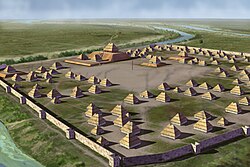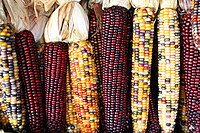Parkin Archeological State Park
Parkin Indian Mound | |
 Artist's conception of the archaeological site | |
| Nearest city | Parkin, Arkansas |
|---|---|
| Coordinates | 35°16′37.70″N 90°33′26.66″W / 35.2771389°N 90.5574056°W |
| NRHP reference No. | 66000200 |
| Significant dates | |
| Added to NRHP | October 15, 1966[1] |
| Designated NHL | July 19, 1964[2] |
Parkin Archeological State Park, also known as Parkin Indian Mound, is an
The Parkin site was declared a National Historic Landmark in 1964 for its significance as a type site of the Parkin phase.[2][3] In 1966, the Parkin Indian Mound was listed in the National Register of Historic Places.[1] Parkin Archeological State Park is located at 60 Arkansas Highway 184 North, Parkin, Arkansas.
Culture of the Parkin phase
The Parkin site is the
In the early 1540s, the
The province was named by the De Soto Expedition for the
Settlement pattern

| Village type | Known sites | Site size | Features |
|---|---|---|---|
| Paramount village | Parkin site | 17 acres (6.9 ha) | |
| Important villages | Barton Ranch(3CT18) Glover Neeley's Ferry(3CS24) Rose Mound(3CS27) |
6.7 to 9.1 acres (2.7–3.7 ha) | |
| Intermediate villages | 9 sites known | 3.7 to 5.9 acres (1.5–2.4 ha) | Palisade and moat, some mounds |
| Smaller villages | 5 sites known | 0.7 to 2.0 acres (0.3–0.8 ha) | |
| Very small villages | Ritter, Togo | < 0.7 acres (0.3 ha) | Palisade, no mounds, no moat |
During the preceding periods, homesteads and small villages had developed throughout the area, but by this time
As time went on, the people of the Parkin phase developed a material culture that increasingly diverged from that of the surrounding phases. Among other indicators, this distinction was characterized by changes in pottery designs and
Agriculture and food

The people of Parkin were intensely involved in
The De Soto chroniclers described the area as being intensely cultivated, and as the most populous they had seen in La Florida. They said there were groves of wild fruit and nut-bearing trees, implying that the Parkin phase peoples must have chosen to retain them while clearing other trees for the cultivation of maize and their other crops.[4] The men hunted such game as whitetail deer, squirrel, rabbit, turkey, and mallard, as well as fishing for alligator gar, catfish, drum, turtles and mussels. The two rivers and the moat must have been a very productive source of fish, as the De Soto chroniclers often mentioned receiving "gifts of fish" from the residents of Casqui.
Language
The people of Parkin were probably
Parkin site 1350–1650 CE
This town was a very good one, thoroughly well stockaded; and the walls were furnished with towers and a ditch round about, for the most part full of water which flows in by a canal from the river; and this ditch was full of excellent fish of divers kinds. The chief of Casqui came to the Christians when they were entering the village and they entertained him bravely. In Aquixo, and Casqui, and Pacaha, they saw the best villages seen up to that time, better stockaded and fortified, and the people were of finer quality, excepting those of Cofitachequi.
— -RODRIGO RANJEL 1547–49[9]
The site was a 17 acres (7 ha) palisaded village at the confluence of the St. Francis and Tyronza rivers. All other sites of the Parkin phase are located on very fertile soil, but not the Parkin site. The soil is not adequate to support the population level that is thought to have resided at the site. It is believed that the large village was located at the confluence of the two rivers because this allowed the residents to control transportation and trade on the waterways.[6]
The site had one large
The other six mounds ranged from 3.2 to 5 feet (1.0–1.5 m) in height. The plaza would have been used for religious rituals and the playing of games such as chunkey and the ballgame.[10] Surrounding the plaza were numerous well-laid out houses, aligned to the axis of the mound and plaza, demonstrating the planned nature of the site.[6] The villages of this area were described as having few if any trees, probably because wood was the primary source of fuel and building materials. The Spanish camped within a nearby grove of trees to avoid the sweltering heat on the floodplain. Homes were built from wattle and daub, with thatched roofs.
The palisade which surrounded the site on three sides was designed for defensive purposes. It had bastions at regular intervals, with archers slots to defend against plundering enemies. Immediately outside the palisade was a large moat, which surrounded the site on three sides and connected to the St. Francis River, which was its fourth side. The area inside the ditch and palisade was 3.2 feet (1 m) higher than the surrounding land. Although the level of the site may have been raised by the inhabitants, it is more likely that dirt and refuse built up in the confined space and raised its level gradually, similar to a tell in the Middle East.
Pottery


Most
The Parkin phase people put a bowl and a bottle into a grave with the bodies, as did the people of the Nodena, Walls, and Kent phases. Pottery made by the Parkin people was built up from strips of clay, and then smoothed out by the potter. This technique was much like that of other
Spanish artifacts

On the day of our arrival, the Cacique said that inasmuch as he knew the Governor to be a man from the sky, who must necessarily have to go away, he besought him to leave a sign, of which he might ask support in his wars, and his people call upon for rain, of which their fields had great need, as their children were dying of hunger. The Governor commanded that a very tall cross be made of two, pines, and told him to return the next day, when he would give him the sign from heaven for which he asked; but that the Chief must believe nothing could be needed if he had a true faith in the cross. He returned the next day, complaining much because we so long delayed giving him the sign he asked, and he had good- will to serve and follow us. Thereupon he set up a loud wailing because the compliance was not immediate, which caused us all to weep, witnessing such devotion and earnestness in his entreaties. The Governor told him to bring all his people back in the evening, and that we would go with them to his town and take thither the sign he had asked. He came in the afternoon with them, and we went in procession to the town, while they followed us. Arriving there, as it is the custom of the Caciques to have near their houses a high hill, made by hand, some having the houses placed thereon, we set up the cross on the summit of a mount, and we all went on bended knees, with great humility, to kiss the foot of that cross. The Indians did the same as they saw us do, nor more nor less; then directly they brought a great quantity of cane, making a fence about it; and we returned that night to our camp.
— - LUYS HERNANDEZ De BIEMA, 1544[11]

In 1966, a Spanish
See also
- Mississippian culture
- List of Mississippian sites
- List of sites and peoples visited by the Hernando de Soto Expedition
- Southeastern Ceremonial Complex
- List of National Historic Landmarks in Arkansas
- National Register of Historic Places listings in Cross County, Arkansas
References
- ^ a b "National Register Information System". National Register of Historic Places. National Park Service. January 23, 2007.
- ^ a b "Parkin Indian Mound". National Historic Landmark summary listing. National Park Service. September 26, 2007.
- ^ Mark R. Barnes (November 25, 1997). "Parkin Indian Mound" (PDF). National Historic Landmark Nomination. National Park Service. Retrieved February 22, 2009.
- ^ ISBN 0-8203-1888-4.
- ISBN 1-56349-057-9.
- ^ OCLC 7540091.
- ^ ISBN 0-8173-0455-X.
- ISBN 0-8173-0455-X.
- ^ "A narrative of de Soto's Expedition based on the diary of Rodrigo Ranjel". Archived from the original on March 17, 2009. Retrieved September 30, 2008.
- Hudson, Charles M.(1976). The Southeastern Indians.
- ^ "Relation of the Conquest of Florida presented by Luys Hernandez de Biema". Archived from the original on October 15, 2008. Retrieved September 30, 2008.
- ^ "The Parkin site:Hernando De Soto in Cross County, Arkansas" (PDF). Archived from the original (PDF) on October 3, 2008. Retrieved September 19, 2008.
- ^ "Parkin Archeological State Park-Encyclopedia of Arkansas". Retrieved September 19, 2008.
- ^ "Arkansas Archaeologists Find the Remains of de Soto's Cross?". The Archaeological Conservancy. April 21, 2016. Retrieved May 13, 2016.


